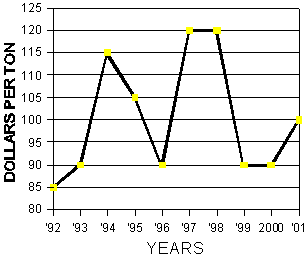Alfalfa Report
Yuma County, Arizona
January 02, 2001
Yuma County Office
2200 W. 28th Street, Ste. 102
Yuma, AZ 85364
(520) 726-3904
(520) 726-8472 FAX
Production Update:
PDF version, 14KB
Phytophthora Root Rot: Phytophthora root rot caused by the fungus Phytophthora megasperma was a major contributor to stand decline in Arizona before 1980. The importance of this disease has been lessened by the introduction of resistant varieties and by elimination of water logging. Phytophthora root rot is a cool season disease induced by wet conditions. A rotted tap root is characteristic of this disease, although leaves turn yellow and drop and lesions also appear on the roots. Infected fields can be saved by providing soil drainage. Lateral roots developing above the infected area can replace the function of the decayed tap root.
Insect Management: Pea aphid are a serious pest of alfalfa during the spring months in the low desert. Pea aphid is distinguished from blue alfalfa aphid by lighter antennae with dark bands at each joint. Blue alfalfa aphids has uniformly dark antennae. Pea aphids first appear in December or January but are usually less abundant than blue alfalfa aphid until later in the spring, but pea aphid may persist into early summer as they are more heat tolerant. Pea aphid and blue alfalfa aphid numbers have been lower than usual for the past two years. Cowpea aphid populations have left little room for other aphid species on alfalfa. They are found over most of the plant with heavy infestations and can deposit large quantities of honeydew which can foul harvesting equipment and supports the growth of sooty molds lowering hay quality. Regrowth may be stunted following cuttings with moderate to heavy aphid populations. Several species of predacious bugs and parasitic wasps attack these aphids. Sample alfalfa fields by taking 5 to 6 stem samples in at least 5 locations per field weekly when aphids appear, then every 2 to 3 days as numbers approach the treatment threshold of 40 to 50 aphids per stem for plants under 10 inches, 70 to 80 per stem for plants 10 to 20 inches tall and more than 100 aphids per stem for plants over 20 inches tall.
Weed Control: Many areas have yet to get cold enough to kill some
summer annual weeds such as sandbor and sprangletop. If these weeds are
not killed with cold, they will come back in the spring from established
crowns. Preemergent herbicides such as Trifluralin and Eptam do not work
on established weeds.
| Market Summary |
High
|
Low
|
Average
|
Off grade
|
| Past 2 Weeks (Dec. 19, 2000 to Jan. 1, 2001) |
105
|
90
|
100
|
70-90
|
| Last Year (Dec. 19, 1999 to Jan. 1, 2000) |
100
|
85
|
90
|
65-80
|
10 Year Summary (December 19, to January 1, 1992-2001):

Issued in furtherance of Cooperative Extension work, acts of May 8 and June 30, 1914, in cooperation with the U.S. Department of Agriculture, James A. Christenson, Director Cooperative Extension, College of Agriculture and Life Sciences, The University of Arizona.
The University of Arizona is an equal opportunity, affirmative action institution. The University does not discriminate on the basis of race, color, religion, sex, national origin, age, disability, veteran status, or sexual orientation in its programs and activities.
Any products, services, or organizations that are
mentioned, shown, or indirectly implied in this web document do not imply
endorsement by The University of Arizona.
Information provided by:
Barry Tickes, btickes@ag.arizona.edu Extension Agent, Yuma County
Michael Ottman, mottman@ag.arizona.edu Agronomy Specialist
College of Agriculture, The University of Arizona.
Eric Natwick, etnatwick@ucdavis.edu UCCE Imperial County - Farm Advisor
University of California, Davis, CA.
Material written January 2, 2001.
Forages: Crop Mgmt | Soil Mgmt | Irrigation | Alfalfa Reports | Insects | Diseases | Weeds | Pesticides
Home | Other Crops | Forages
For more Arizona Production Ag Information:
Home | Cotton | Veggies| Forages | Grains | Citrus | Crop x Crop | Insects | Diseases| Weeds | Pesticides | News | Weather | Research | Photos | Contacts | General Info. | Site Map
Copyright © 2001 University of Arizona,
College of Agriculture and Life Sciences
Webmaster: Al Fournier (fournier@ag.arizona.edu)